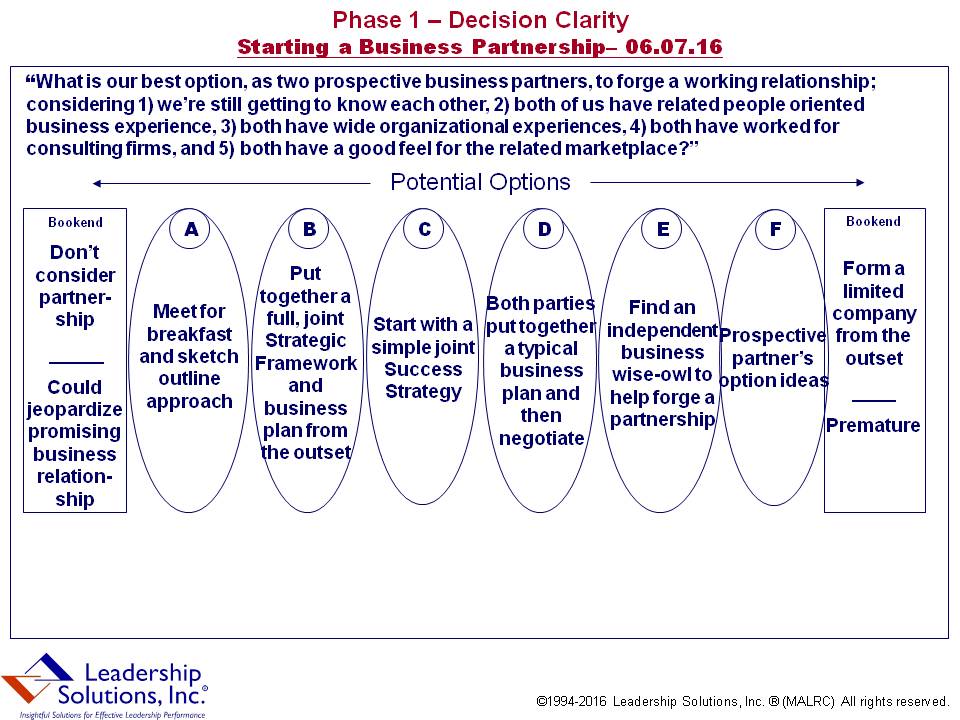A positive business relationship started to build when an experienced executive from the human resources field approached a friend about exploring the possibility of a partnership. Once the possible partnership was brought to this writer’s attention, it prompted this writer to consider some of their potential options before having a joint venture discussion with them.
Using the option solving approach, this writer immediately started formulating an appropriate question for them, such as: “What is our best option, as two prospective business partners, to forge a working relationship; considering 1) we’re still getting to know each other, 2) both of us have related people oriented business experience, 3) both have wide organizational experiences, 4) both have worked for consulting firms, and 5) both have a good feel for the related marketplace?” There were more considerations, but this writer stopped at around 50% of the most vital ones so as not to make the picture too complex…take a look at the example further below.
Considerations are important to decision making because they provide the right context. Trouble is, with our traditional analytical approach to decision making, we reject as many considerations as is possible because they get in the way of the decision process. In option solving considerations are welcome.
This writer then set-about producing two framing yin and yang “bookends,” which were designed to stimulate the potential partners’ out-of-the-box thinking when producing at least five realistic alternatives. These bookends were intended to be their least likely options. They were, “Don’t consider the partnership” and “Form a limited company from the outset.” The example further below shows why these two bookend options were the least workable ones.
With this writer’s question and bookends in place, it was then necessary within the option solving approach to come-up with at least five alternative, practical options to stretch the potential partners’ out-of-the-box thinking. Six options were produced because this writer wanted to give them the possibility to come up with other options of their own. That way they would have greater buy-in to this approach, as well as the outcome, when the time comes.
You can see that one of this writer’s options was “Option C – Start with a Simple Success Strategy.” A success strategy is based upon three interlinking components that drive an organization to optimum success; those three factors being Compelling Vision and associated Strategies; the required People Power; and the necessary Effective Leadership…You can always contact this writer at peter@ileadershipsolutions.com or through LSI’s Website www.ileadershipsolutions.com for further advantages and insights in using the success strategy approach.
You will also notice below a second option-solving “pictogram,” which transpired from both likely partners sitting down together and reviewing the first version……
 |
 |
In fact, once they had agreed on their version of the ‘F’ Option, they were invited to take some emotional distancing time before casting their personal option vote. (NOTE: Emotional distancing time allows for their intuitions to subconsciously reflect on the pictogram for a reasonable period of time. During that time the pictogram is either turned over or removed from their view.)
In their case, they turned the pictogram over to be out of sight and then went off for some lunch to talk through the general issues of forming any likely future partnership. When they returned, they turned it back over, reflected on it for a few moments, and then came up with their personal vote.
As you can see, one picked option C and the other option E; whereupon they agreed to initially pursue C and then E. Not only was this agreed with minimal fuss, they were both emotionally behind such moves…both the minimal fuss and participants getting behind a consensus view are two factors among the many advantages of option solving.
Suffice it is to say that option solving brings many advantages over traditional, rational decision making. Not least, it allows people to utilize their enormous intuitive powers over their rational capability. According to some experts, whereas our rational mind can process around 40 pieces of information per second; our intuitive mind by comparison can process around 11 million pieces of information per second. We’re sure you will agree that’s a phenomenal difference.
Our challenge as organizational leaders is to encourage our people to tap into this enormous power difference. Option solving is one technique for doing that and that’s why it is Phase 1 – Decision clarity – within Enlightened Leadership.
The only other thing these potential partners were encouraged to do, following their decision conclusions, was to draw up an action initiative while everything was still fresh in their minds. Such immediate purpose also encourages them to stick with their decision instincts, rather than second guess themselves. The latter could prove fatal.
We will deal with success strategies – Phase 2 of Enlightened Leadership – in our next blog in 2 weeks time.
